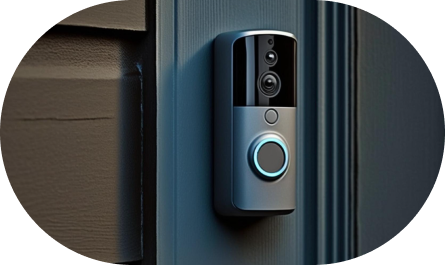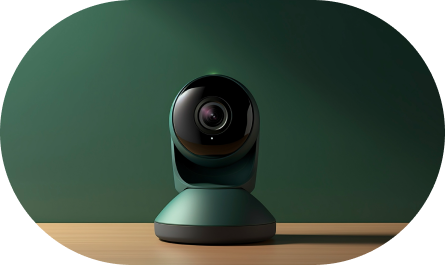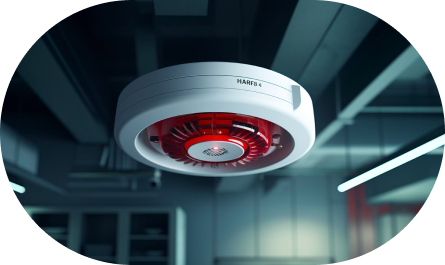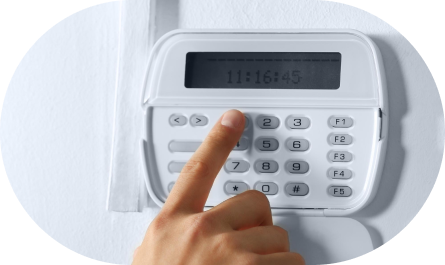A Complete
Home Automation Guide
for 2024 and Beyond

Fed up with running to the grocery store after a hard day’s work, only to find that you’ve forgotten a key item?
Do you fantasize about having your morning coffee ready as soon as you wake up? With your very own smart home, these problems can be solved in an instant, and your dreams can become a reality.
X10 communication protoco

x10 Controller

x10 Transceiver

x10 Appliance module

Lamp
Beginning with the invention of the X10 communication protocol back in the 1970s, home automation systems have been blessing our lives with ultimate comfort and convenience for decades.
However, smart homes as we know them today are more advanced than ever, spanning everything from remote door-locking systems to one-touch light controls.
Thanks to the ever-expanding Internet of Things (IoT), we’ll soon be living within a completely interconnected world of homes, cities, and transportation.
With the ever-changing technological trends and rapid advancements in this industry, knowing which home automation options best suit your needs can be difficult.
To help you navigate the world of smart homes, we therefore present our comprehensive home automation guide, which will guide you through the basic concepts, benefits, and best choices for your family in 2024 and beyond.
Home
Automation Stats
Over the past decade, smart technology has advanced rapidly, delivering home automation systems that can truly enhance the comfort, security, and quality of our lives.
The smart home system can enhance our lives through the following three factors:
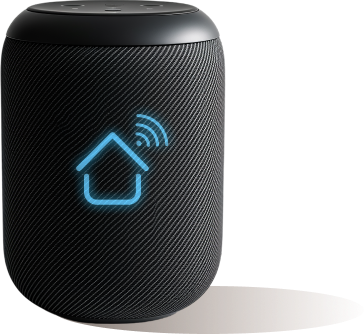
comfort
security
quality
As a result, the global market size and revenue have significantly increased. In 2020, the home automation market reached a value of $44.88 billion and is expected to grow at a CAGR of 10.42% from 2021 to 2028. By the end of this period, the industry is valued at a huge $97.06 billion.
The home automation market in 2020 reached a value of
Expected to grow at a 10.42% CAGR from 2021 to 2028.
Whereas in the past, home automation was considered a novel, lavish expense that only the rich and famous could afford, now it is a key feature in millions of homes across the world.
For instance, there are an estimated 300 million smart homes worldwide, with around 63.4 million smart home users recorded in the US during 2023. While the household penetration rate currently stands at 52.4% in 2024, by 2028 it’s set to reach 75.1%, meaning that 3 in every 4 US homes will have some form of automation.
300 million smart homes worldwide
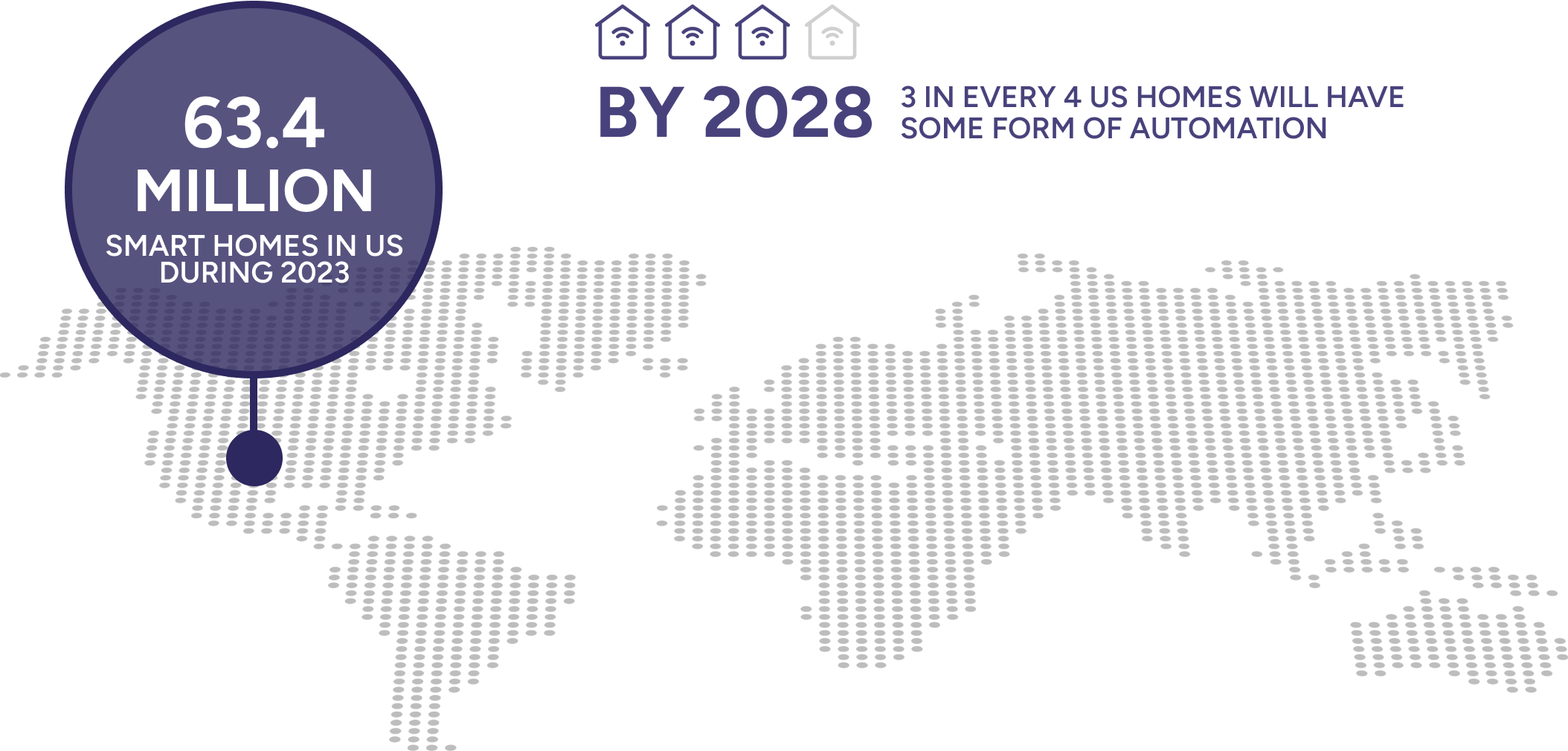
Major key players in global market share for home automation
Market share
33.74% in 2022
United States
Although China, Germany, South Korea, and the United Kingdom are all key players, the United States continues to be the dominant home automation leader, with a market share of 33.74% in 2022. In a global comparison, the US was predicted to generate the most revenue in 2024, with projected figures of $38.8 billion.
When considering these new trends and market figures, it’s safe to say that the convenience, cost-effectiveness, and energy-saving features of smart home technology are firmly here to stay.
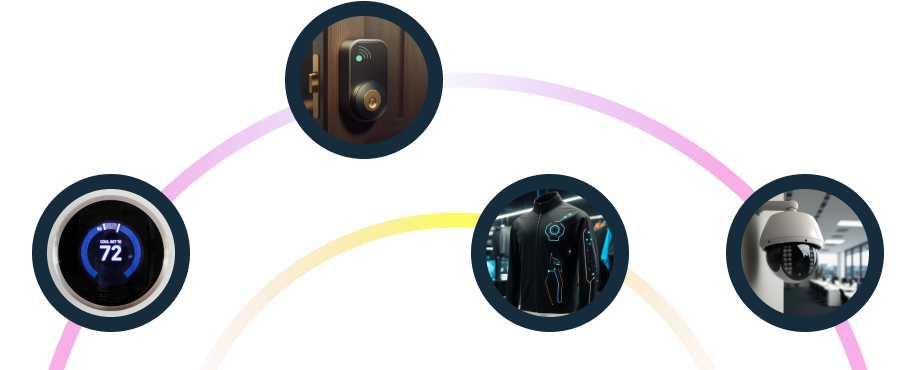
Projected New Adoption
of Connected Technology
By Consumers
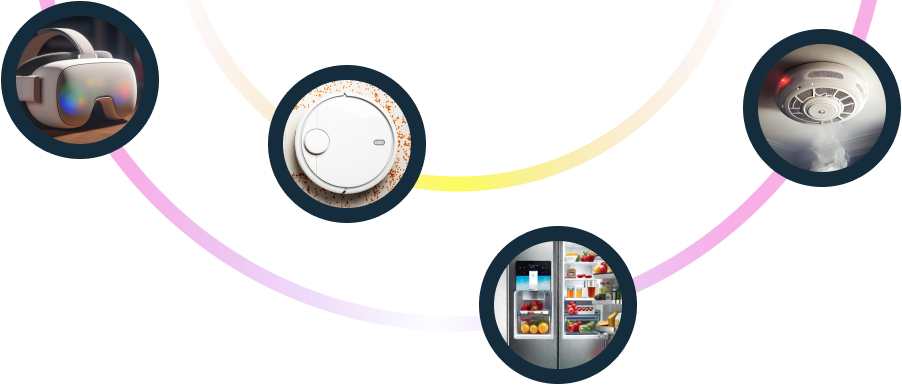
After an industry-wide focus on automation and energy efficiency over the past year, smart home technology brands in 2024 are looking to harness the power of AI with home security and entertainment devices.

Thanks to the new Matter standard, a certification that encourages interconnection between devices, companies can also focus on seamless smart home integration.
These trends highlight the increasing accessibility of home automation to a wider audience, but which technologies are expected to become the most popular in our smart homes?

Some of the predicted top consumer purchases for 2024 include the following:
Smart Thermostat
Typically operated through Wi-Fi, smart thermostats automatically adjust the temperature within your home. Many thermostat devices adapt to your preferences, learning when you prefer heating and cooling temperatures and at what points during the day.
Energy Tracking and Reports
Voice activation feature

geofencing location-based technology

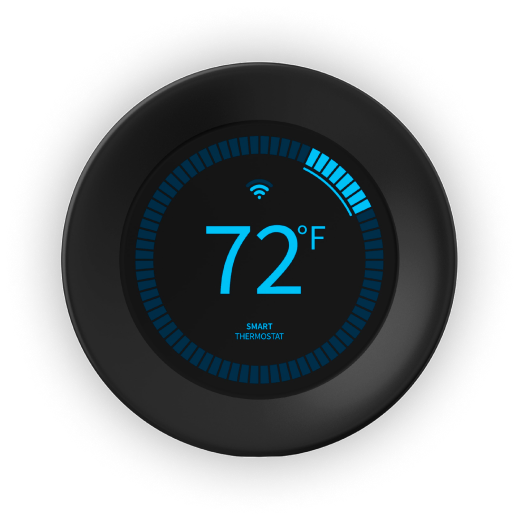
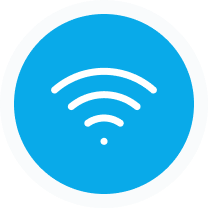
operated through Wi-Fi

automatically adjust the temperature

Smartphone compatibility
Energy Tracking and Reports

Voice activation feature

geofencing location-based technology

operated through Wi-Fi

automatically adjust the temperature

Smartphone compatibility
A type of location-based technology called geofencing, which connects with an app on your smartphone, also alerts the thermostat when you’re on the way home. So, by the time you reach the front door, your living space should have reached the perfect temperature.
Connected Security System
As part of the integration of home automation technology into our daily lives, security systems are a huge priority, providing the peace of mind we need to continue with our busy daily lives.
Smart security systems consist of various electrical devices that work together to deter intruders, alert you to emergencies, and protect your home overall. Depending on your budget and the level of security required, some of the main components you may include are:
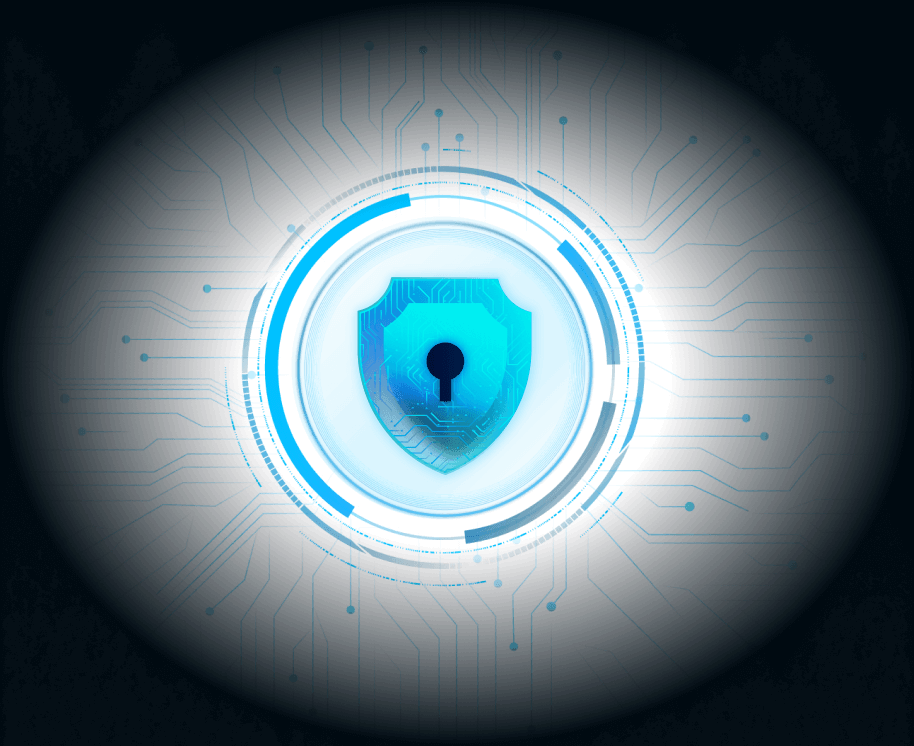
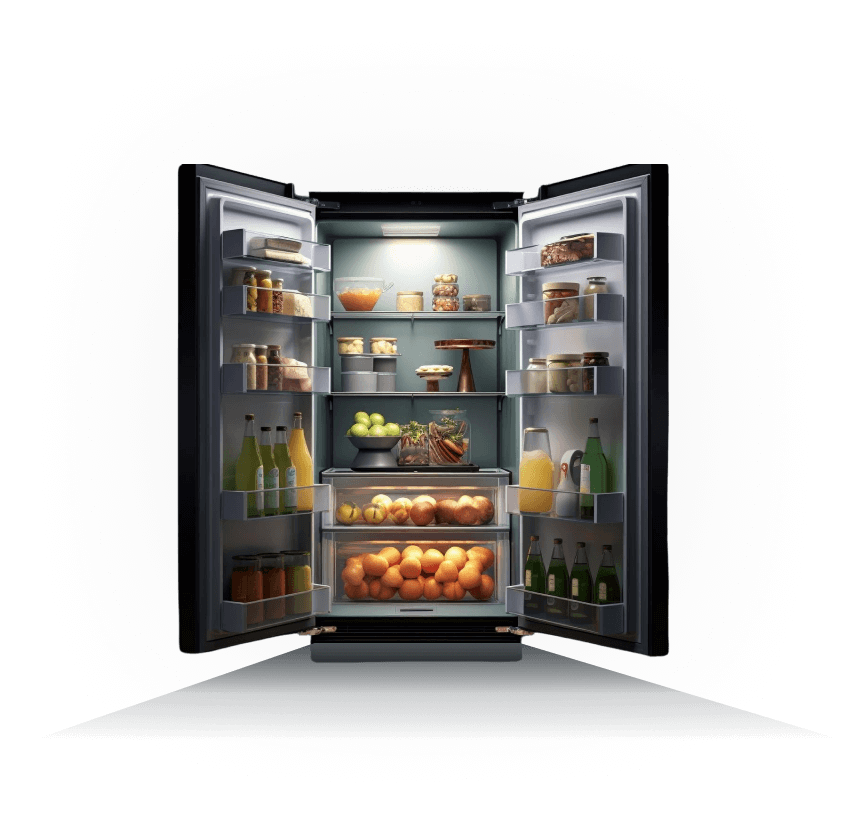
Smart Refrigerator
Compared with regular kitchen appliances, smart refrigerators are much more energy-efficient.
This is because they are powered by AI (artificial intelligence), which offers energy-saving features such as alerts when doors are left open, displaying the inside without needing to open doors, and carefully monitoring any issues.
Smart fridges also maintain the perfect temperature for preserving foods in every compartment, while their inner sensors and cameras allow you to easily track when items are due to expire. Together, these features contribute to reducing food waste.

More energy efficient

smartly monitoring problem

powered by AI (artificial intelligence)

displaying the inside without needing to open doors

alerts when doors are left open
Wearable Fitness Device
As suggested by the name, wearable fitness devices are designed to monitor your activity levels. They have the capability to track a variety of health-related metrics, such as number of steps completed, heart rate, calorie consumption, sleep quality, and blood oxygen levels.
number of steps completed

heart rate Monitoring

calorie consumption

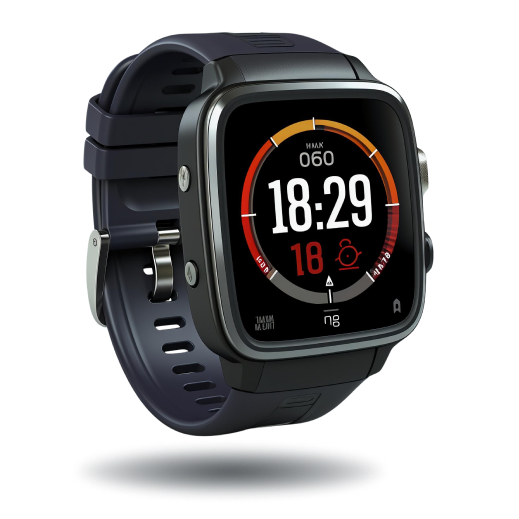

sleep quality monitoring

blood oxygen levels

Workout and activity records
number of steps completed

heart rate Monitoring

calorie consumption

sleep quality monitoring

blood oxygen levels

Workout and activity records
Although typically worn on the wrist, fitness trackers can be found in the form of earbuds and clip-on devices, which are all monitored through a wirelessly synced smartphone app.
While popular with health-conscious consumers, wearable devices are also being used as part of research and development strategies. For example, Fitbit has collaborated with Stanford Medicine researchers to study how these smart devices could be used to detect early signs of infectious disease.

Self-Driving Vacuum Cleaner
If you’re looking for a way to streamline your cleaning routine, robotic vacuum machines could be the way forward. Using sensors, these machines navigate their way around your home without being pushed, creating maps to memorize where obstructions lie.
Many self-driving vacuum cleaners can also take voice commands, and even empty themselves at the end to save you precious time and effort.
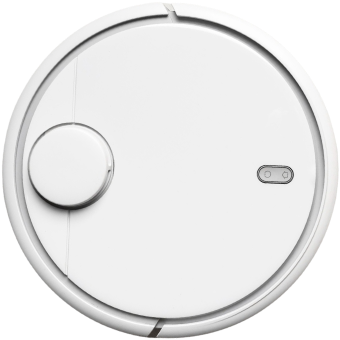

Save your precious time

voice commands

empty themselves
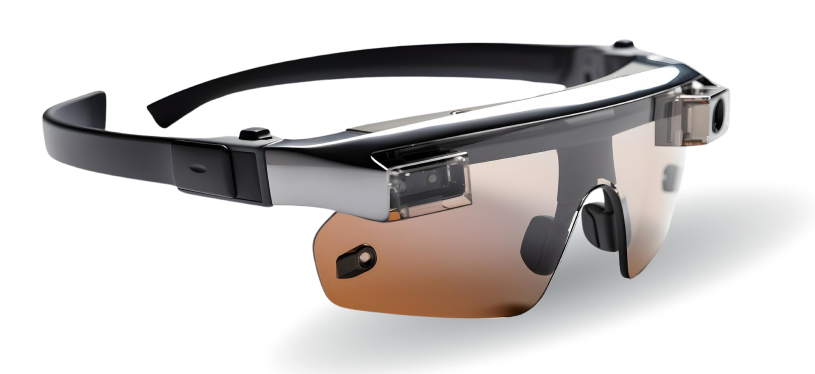
Wearable Heads Up Display
Heads up displays (HUD) are units worn on the head that project important information through a transparent screen. Traditionally, HUDS are attached to pilot helmets without blocking the view ahead, so users can receive altitude and orientation data while remaining focused on the flight path.
However, thanks to the integration of HUDs into sunglasses and budget-friendly cars, these wearable devices are becoming more popular in the mass market for displaying information that’s on your smartphone when walking or driving.
Smart Clothing
Today, not only does clothing keep us warm or help us express our unique personalities, but it can also connect with smartphone apps that provide extra functionality, comfort, and health monitoring features.
From socks to sleepwear, smart clothing is interwoven with technologies such as sensors, advanced textiles, and hardware that perform a variety of interesting functions, particularly when it comes to fighting chronic disease.
For instance, smart activewear can help record and optimize your fitness activity, while night clothes release infrared light to improve your sleep quality.


connect with smartphone

health monitoring

advanced textiles

Record fitness activity

improve your sleep quality


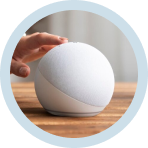
Key Factors for
Home Automation
With thousands of options available, getting into home automation can be daunting. Many consumers start with impulse purchases and then add components as and when needed, but this can end up costing you more in the long term.
Plus, you’ll end up lumbered with devices that don’t add any value to your home set-up or quickly become outdated. So, to minimize this, here are our tips for making wise home automation purchases:

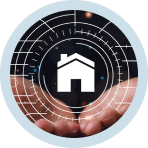
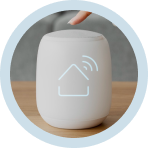
Zero-in on a budget
From complete automation packages for kitting out an entire home to single devices or appliances, there is a wide range of smart home options available at different costs.
With so many options, it can be tempting to keep purchasing brand-new, impressive automation devices whenever they’re launched. However, this approach leaves you with a random assortment of appliances and gaps in the system. As a result, the cost of filling in these gaps can start to mount up.

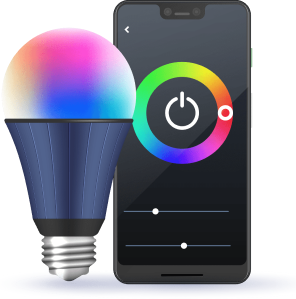
To stop this from happening, come up with a realistic figure that allows you to make all the necessary purchases without breaking the bank.
Start small at first before gradually expanding your ecosystem, prioritizing the most critical areas that deliver immediate value, such as smart lighting or thermostats.
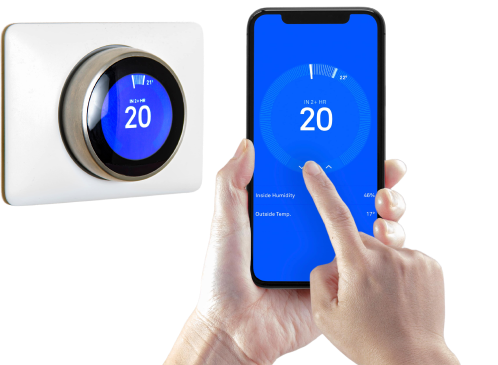

Along the way, try to look for deals and discounts on devices that you’re already planning to purchase. You’ll most often find promotions during events like Black Friday or Cyber Monday that can help you stay within budget.

cyber monday sale ✱ cyber monday sale ✱ cyber monday sale ✱ cyber monday sale ✱ cyber monday sale ✱ cyber monday sale ✱
cyber monday sale ✱ cyber monday sale ✱ cyber monday sale ✱ cyber monday sale ✱ cyber monday sale ✱ cyber monday sale ✱
cyber monday sale ✱ cyber monday sale ✱ cyber monday sale ✱ cyber monday sale ✱ cyber monday sale ✱ cyber monday sale ✱
cyber monday sale ✱ cyber monday sale ✱ cyber monday sale ✱ cyber monday sale ✱ cyber monday sale ✱ cyber monday sale ✱
cyber monday sale ✱ cyber monday sale ✱ cyber monday sale ✱ cyber monday sale ✱ cyber monday sale ✱ cyber monday sale ✱
cyber monday sale ✱ cyber monday sale ✱ cyber monday sale ✱ cyber monday sale ✱ cyber monday sale ✱ cyber monday sale ✱
cyber monday sale ✱ cyber monday sale ✱ cyber monday sale ✱ cyber monday sale ✱ cyber monday sale ✱ cyber monday sale ✱
cyber monday sale ✱ cyber monday sale ✱ cyber monday sale ✱ cyber monday sale ✱ cyber monday sale ✱ cyber monday sale ✱
Black Friday sale ✱ Black Friday sale ✱ Black Friday sale ✱ Black Friday sale ✱ Black Friday sale ✱ Black Friday sale ✱
Black Friday sale ✱ Black Friday sale ✱ Black Friday sale ✱ Black Friday sale ✱ Black Friday sale ✱ Black Friday sale ✱
Black Friday sale ✱ Black Friday sale ✱ Black Friday sale ✱ Black Friday sale ✱ Black Friday sale ✱ Black Friday sale ✱
Black Friday sale ✱ Black Friday sale ✱ Black Friday sale ✱ Black Friday sale ✱ Black Friday sale ✱ Black Friday sale ✱
Black Friday sale ✱ Black Friday sale ✱ Black Friday sale ✱ Black Friday sale ✱ Black Friday sale ✱ Black Friday sale ✱
Black Friday sale ✱ Black Friday sale ✱ Black Friday sale ✱ Black Friday sale ✱ Black Friday sale ✱ Black Friday sale ✱
Black Friday sale ✱ Black Friday sale ✱ Black Friday sale ✱ Black Friday sale ✱ Black Friday sale ✱ Black Friday sale ✱
Black Friday sale ✱ Black Friday sale ✱ Black Friday sale ✱ Black Friday sale ✱ Black Friday sale ✱ Black Friday sale ✱

Hire expert professionals for the job
Though DIY may be useful if your budget is tight, installation isn’t an area you should compromise on. Home automation systems that aren’t set up or configured properly can cause more problems than they solve, especially if you have limited technical knowledge.
For instance, you may find smart lighting or heating systems turning themselves on at the wrong times, which negates the energy and cost-efficiency benefits of these automations.
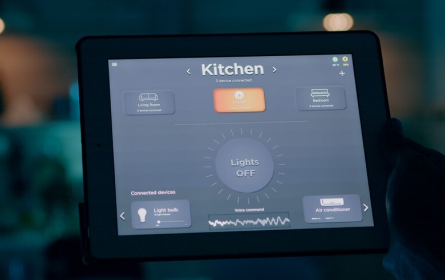
Some wireless devices may be easily set up through simple smartphone apps. However, installing hardwired devices often involves drilling into walls, handling wiring, or climbing ladders, which can go wrong unless you’re extremely confident. So, especially for those bigger, more complex systems, factor professional installation into your budget.
Considerations and Challenges of Installing Hardwired Devices

Drilling Into Walls

Handling Wiring

Climbing Ladders
Choose devices wisely to save on power bills
As we’ve discussed, the excitement of new device launches can trigger impulse purchases. However, before you splurge on the latest voice assistant or automatic vacuum, think about where you really should be investing to make the most savings long-term.

Voice control enabled
25x longer than regular bulbs
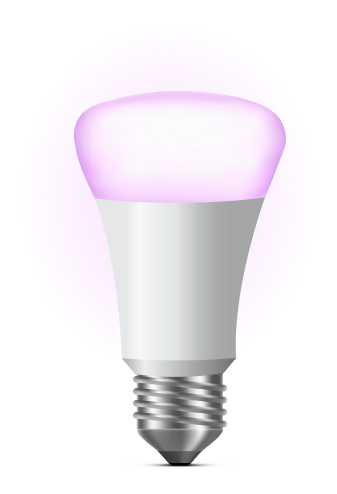
Control the brightness level
Use around 75% less energy
One area to invest in is lighting. Smart bulbs are a great place to start, as they require little expertise to install and are relatively cheap. Plus, all smart bulbs are LED, which last 25 times longer than regular bulbs, use around 75% less energy, and have dimming options that save another 40%.
Electricity consume from the total electricity generated.

annually, the cost of air conditioner usage.
Research also shows that traditional air conditioning is one of the biggest expenses for US households, using about 6% of the total electricity produced and costing $29 billion annually. Choosing a smart thermostat is therefore an effective strategy for lowering these costs by optimizing your home’s cooling systems and preventing fuel waste.
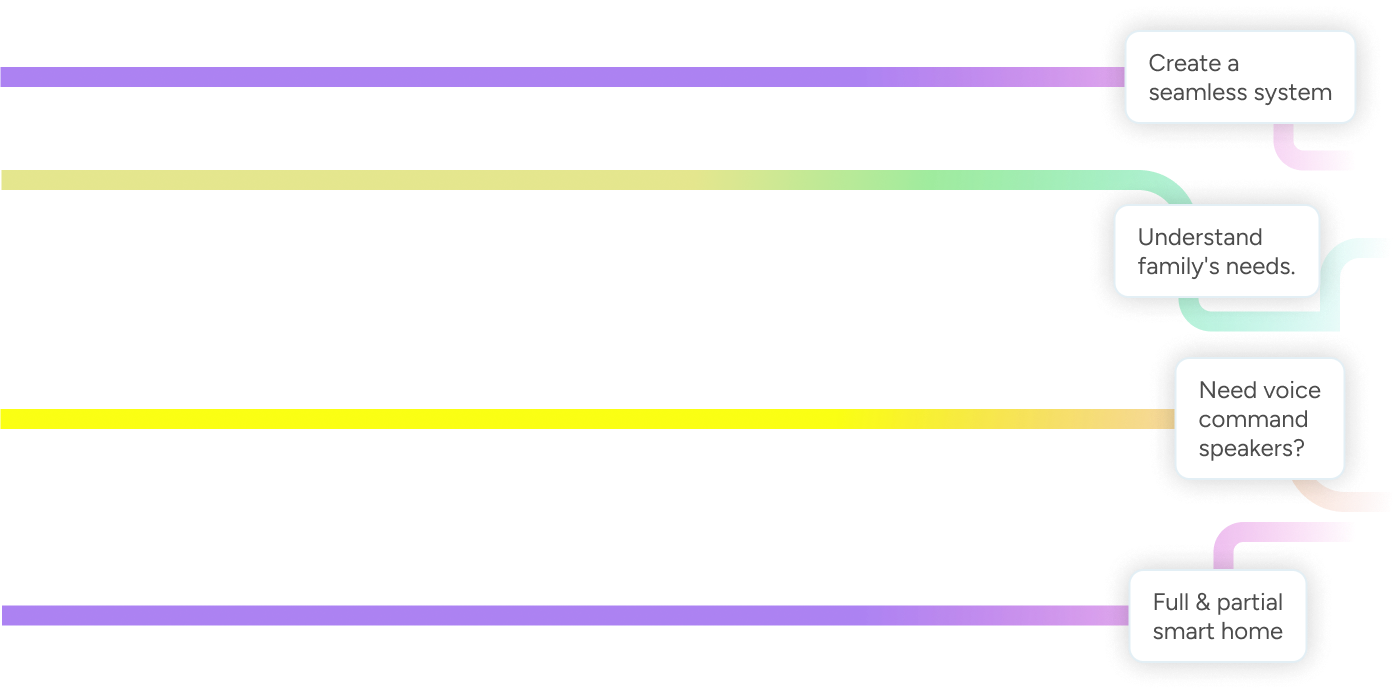
Keep the end goal in mind
From making life more convenient to keeping your loved ones safe, home automation systems offer a range of benefits that we’ll explore later on in this guide.
When deciding which devices to dive into first, we’d recommend considering the benefits you’re most hoping to achieve from your smart home installation, as this could help you make the best and most useful purchases. For instance, you can create a seamless system by buying devices that pair together throughout your home.
Ask yourself a few basic questions, such as “Do I want a full smart home conversion?” or “Am I happy with a few basic automations and voice command speakers?” Starting the shopping journey with an end goal in mind allows you to build your ideal home set up around the needs of you and your family, rather than limiting yourself to the functions of each device.
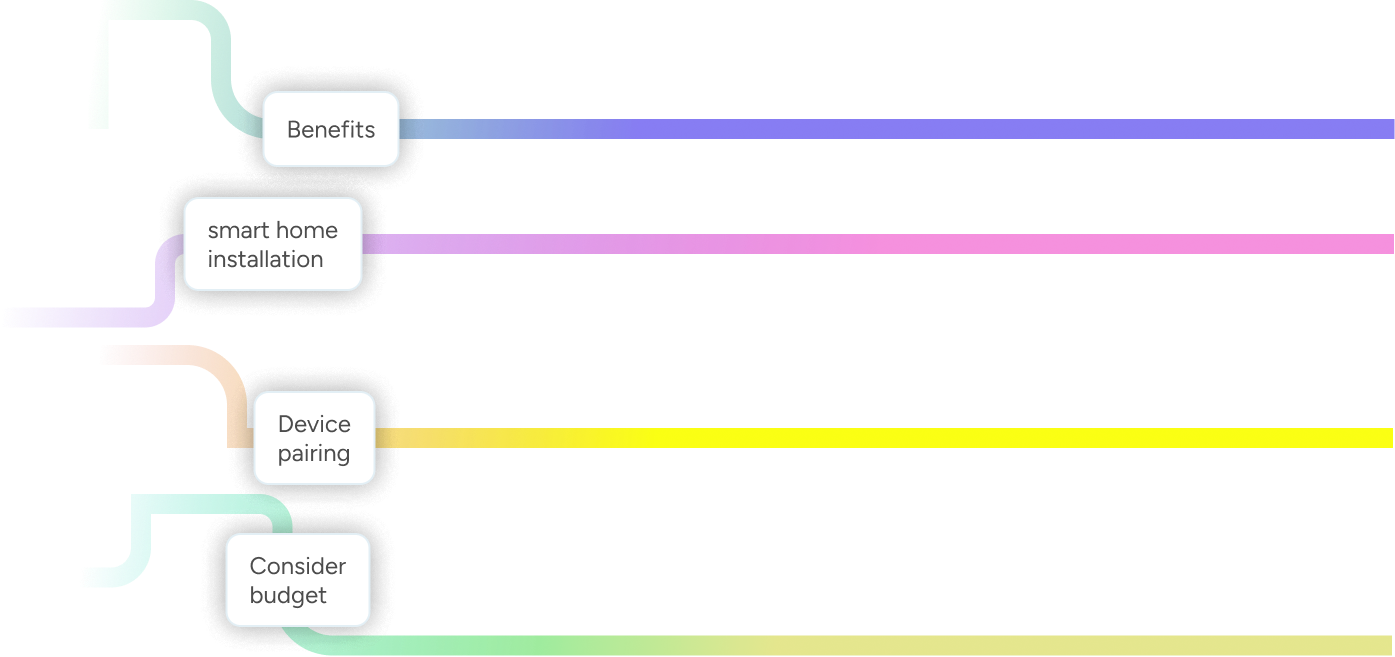
Make way for easy maintenance and updates
Like any smartphone, tablet, or computer, smart home systems require regular updates to install the latest software, fix bugs, and keep them working efficiently. Without updates, you may run the risk of these systems malfunctioning and make yourself susceptible to online or in-person security breaches.
When selecting your home automation devices, it’s therefore essential to understand the correct protocols for performing updates. Find out whether the software automatically updates, whether you’ll need to manually install new features, or hire professional help.
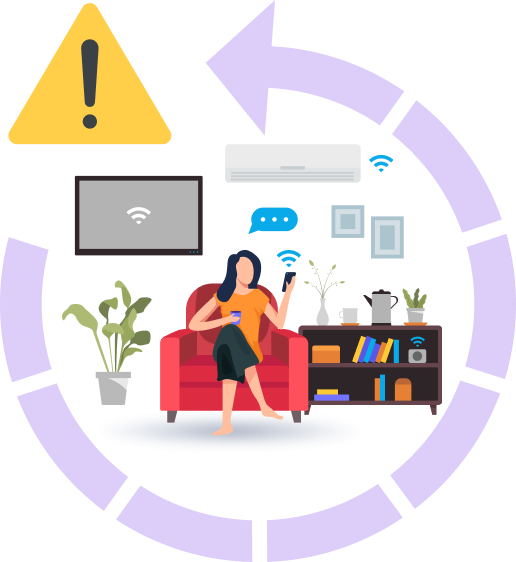
As part of your maintenance routine, keep an eye out for performance issues like poor connectivity or slow responses, and be sure to consistently clean devices to prevent dust or grime from building up.
Settle for easy-to-use devices
Unless you’re a tech wiz, avoid choosing smart home devices with complex instructions and maintenance routines. This is likely to cause confusion, meaning you’ll either give up on the device before you’ve even started or fail to get the most from your automation system.
To ensure you’re keeping on top of updates and reaching optimal efficiency, select automation appliances that are user-friendly. The best way to do this is by picking devices that are all compatible with one platform, allowing you to stay organized and manage your whole home with just a single app.

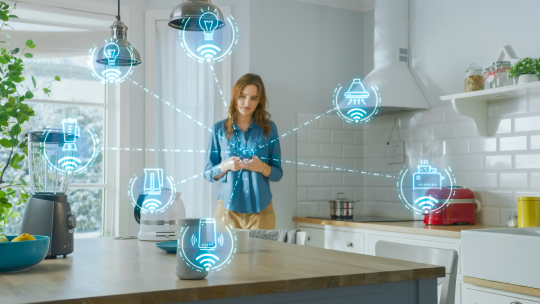
A great example is Matter devices, which work with most major platforms like Apple Home, Amazon Alexa, Google Home, and Samsung SmartThings.
Launched in 2022, the Matter standard is a communication protocol that makes smart homes easier to operate by connecting and controlling devices together, all in one place.
The Home
Automation Process: 3 Key Parts
If you’re unsure of where to begin in the home automation process, there are 3 distinct categories that smart devices can fall into. To help you decide which products are best for you, read our summary of each category and their key features below.

Home Appliances

Furniture
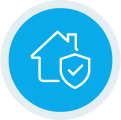
Security System
Home Appliances
According to the International Data Corporation (IDC), global shipments of smart home devices declined for the first time in 2022, falling by 2.6% to 871.8 million units. However, as the economy continues to recover post-COVID-19 pandemic, figures are expected to rise again, growing at a CAGR of 14.45% between 2022 and 2027.
Video entertainment appliances led global shipments in 2023, followed by lighting and thermostat devices.
Of these connected home appliances, statistics show that video entertainment appliances had the highest rate of worldwide shipments in 2023 at 278.8 million, followed by lighting and thermostat-controlling devices.
Research from Technavio suggests that this is driven by the growing adoption of wireless connecting devices in the Internet of Things. Mobile devices can utilize wireless technologies like Wi-Fi, Bluetooth, and ZigBee to control appliances like air conditioners, while Near Field Communication (NFC) allows smart washing machines to be switched on at the touch of a smartphone screen.
And that’s not all – with the increasing adoption of home automation, consumers with smaller homes also want in on the action. As a result, manufacturers are looking at ways to develop appliances with connectivity features, sleek designs, and accessories that help save on storage space.
Some of the most common smart features you’ll recognize on popular home appliances include:

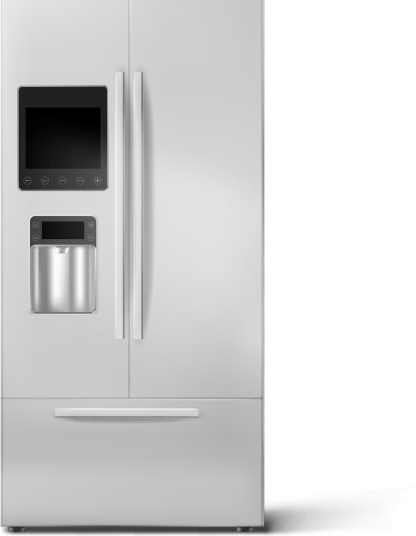
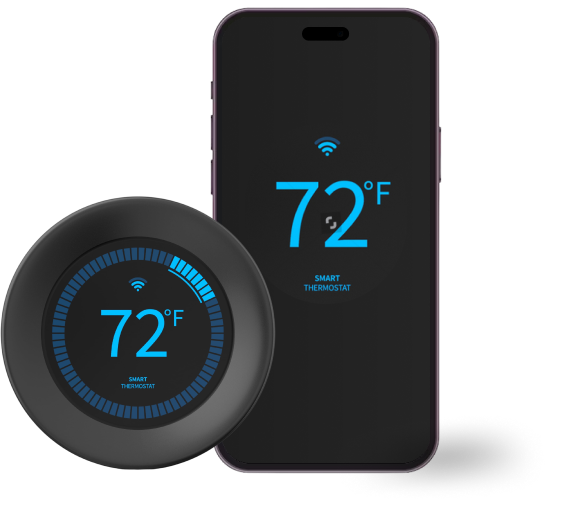
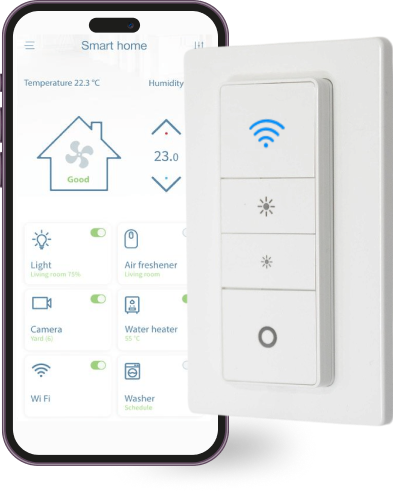

Other popular devices that make your home smarter include voice assistants such as Google Home or Amazon Alexa. These connected systems can help you build a smart home, allowing you to control everything from smoke alarms to the music that’s playing.
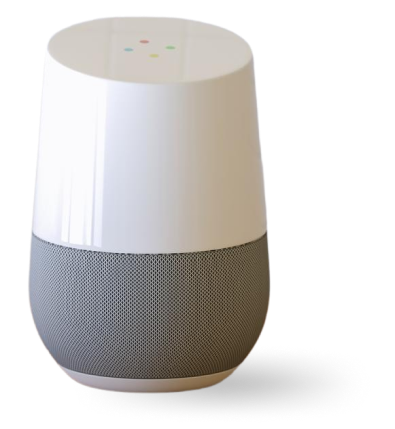
Furniture
In the modern home, there’s no longer any need to sacrifice sleek and stylish furniture for functionality. Combining innovative design with electronics and enhanced functionality, the invention of smart furniture means that you can relax in ultimate comfort, which is essential in today’s non-stop society.
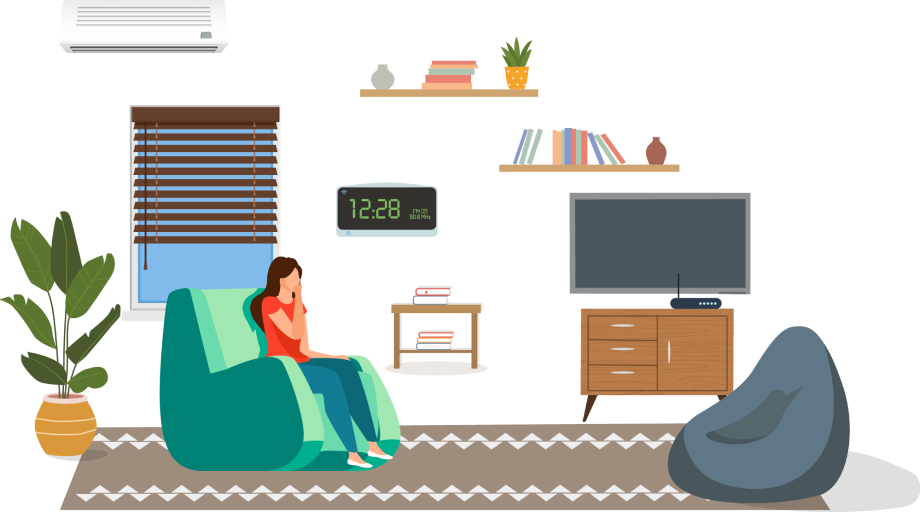
Plus, the ever-growing investment in and development of new connected technologies ensures that smart furniture also offers convenience. Swivel tray tables, accessory docks, and USB charging ports make it so that once you’re settled down for the night, you won’t need to lift a finger – only when you’re ready to jump into your cozy smart bed!
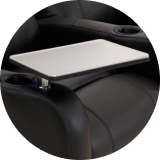
Swivel Tray Tables

Accessory Docks

USB Charging Ports
From 2022 to 2032, the global smart furniture market is forecast to grow at a CAGR of 10%, reaching a value of $5.6 billion by the end of the period.
Smart furniture should be multitasking, space-saving, convertible, and good-looking, so look out for the following features if you’re thinking of upgrading your family’s living space:
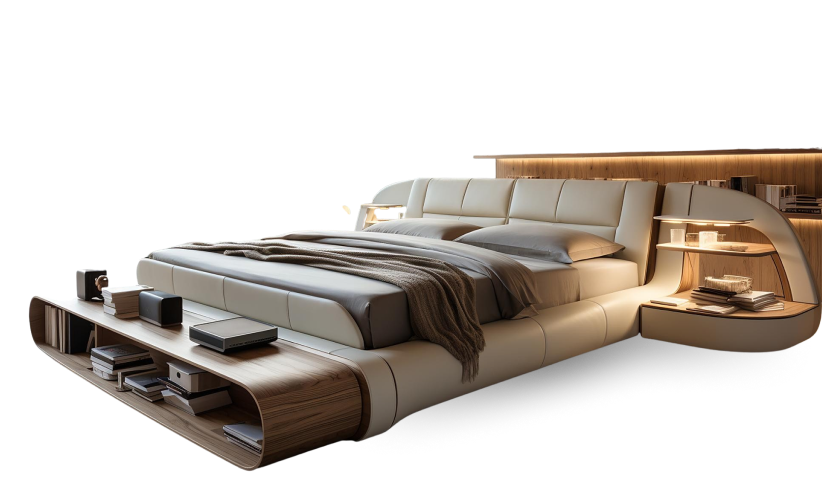
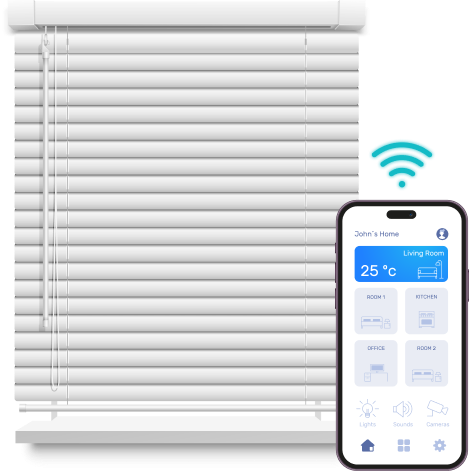
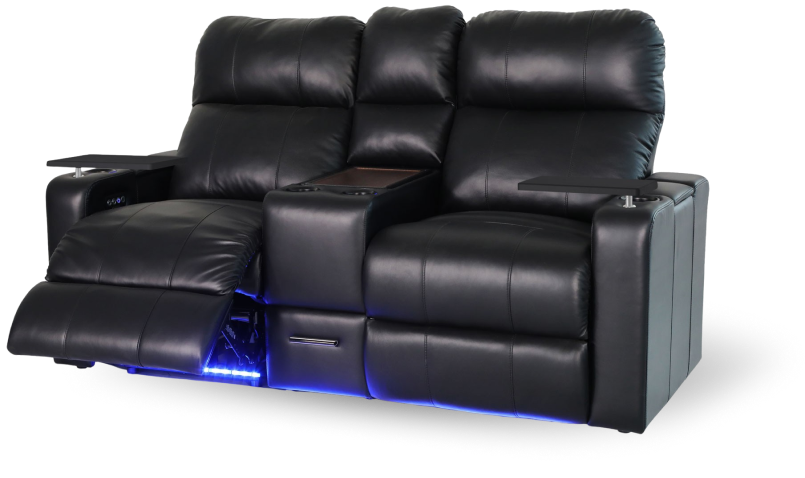

Safety & Security System
Despite being a luxury for some, home automation is quickly becoming a necessity for many of us who are looking to keep our properties and families safe.
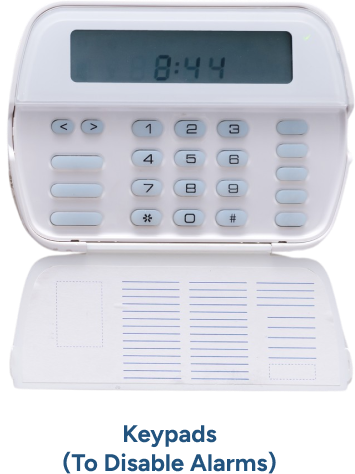
In fact, when it comes to connected devices, smart home security is the leading product category for intended purchases over the next year. Among the most important smart security devices available on the market are burglar alarms and surveillance cameras.
In a survey of convicted burglary offenders, 83% said that they would try to determine if an alarm was present before attempting a break-in, and if so, 60% would seek an alternative target. Having true smart monitoring is therefore invaluable.
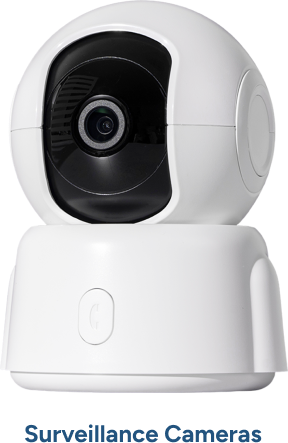
What’s great about smart security devices like these is that they can be operated from either one or multiple devices, whether you’re on an office computer or out for the day with only your mobile phone. This means that they can be controlled remotely, allowing you to keep an eye on your home and receive activity alerts if a security alarm, motion detector, smart lock, or sensor is triggered.
Plus, you won’t need to worry about these systems switching off unknowingly; most are built with long-lasting batteries and power backup systems so that you can respond to potential threats before they escalate. Although they may be an investment, having a good alarm system can also provide insurance discounts of 15 to 20% on your premium.
Investing in a quality alarm system can lead to insurance discounts ranging from 15% to 20% on your premium.
US citizens die in house fires each year
Along with deterring unwanted visitors when you’re away, automated safety devices help to protect the people you care about most while within the four walls of your sanctuary. Sadly, nearly 4000 US citizens die in house fires each year, and over 2000 are severely injured.
Individuals suffer severe injuries from house fires yearly
It takes just 3 and a half minutes for the heat of a house fire to reach 1100 degrees Fahrenheit, and even in rooms that aren’t overcome with flames, the temperature can reach over 300 degrees. This is hot enough to melt plastic and kill anyone residing in these rooms.
These facts and figures explain the growing importance of automated fire alarms, smoke alarms, and heat sensors within our homes.
By installing a simple app on your smart device, you can test your alarm using voice commands at any time to check that it’s working, and get instant mobile alerts if smoke is detected anywhere on your property.
You may also have the option to install interconnected alarms, which all sound together when one is triggered.
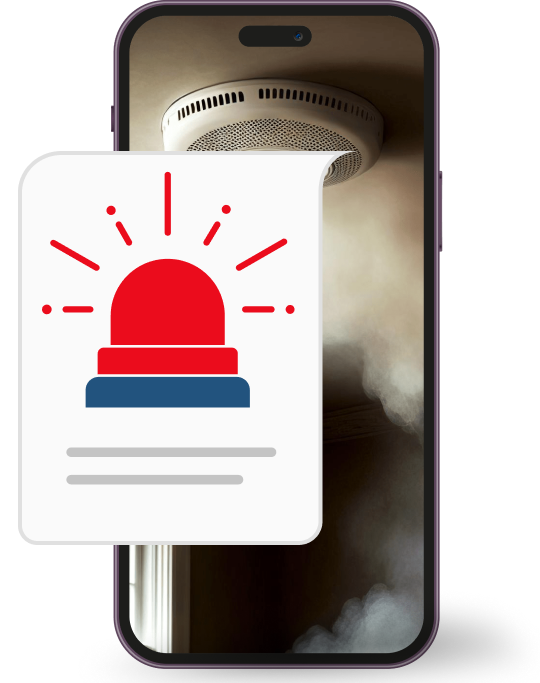
5 Key Benefits of Home
Automation
Comfort
Energy
Conservation
Time Saving
Security
Remote
Monitoring
With exciting smart gadgets and devices constantly being launched onto the market, it’s easy to think of home automation as just another type of cool technology that makes us feel as if we’re going “Back to the future!”
However, home automation puts us in greater control of our lives, and offers several advantages for homeowners. We took a closer look at exactly how diving into the world of smart homes can benefit your daily life:
01
Comfort
Ultimately, one of the main goals of any smart device owner is to improve comfort and convenience, and home automation can do this for you.
There’s nothing worse than getting into a warm, cozy bed after a long day and realizing you’ve left the downstairs light on, or settling down on your smart recliner ready to watch a movie and spotting the remote control on the other side of the room.
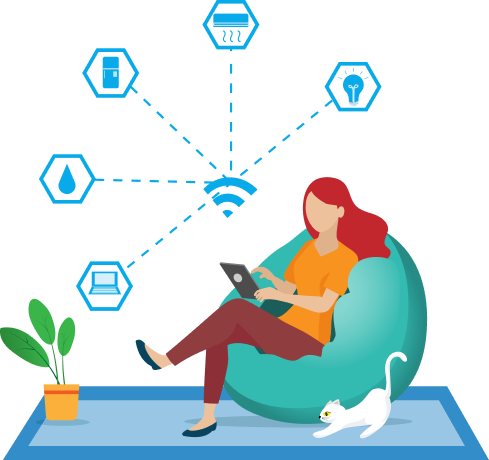
With smart appliances situated throughout your home, these scenarios will no longer be problems. Interconnected devices can be programmed to create the comfortable atmosphere you’ve always dreamt of, whether you want automatic bright lighting to set you up for the day, or gentle, soothing music to greet you as you walk through the door.
Your devices are linked together at home for your convenience.

CCTV Camera

Washing Machine

Air conditioner

Smart Lamp

02
Energy Conservation
Did you know that nearly half of all home energy costs are connected to heating and cooling systems?
As these systems rely on you constantly adjusting the temperature, when you’re out of the house they can waste energy on rooms that aren’t in use and run less efficiently than desired.

However, by investing in a smart thermostat or air conditioner, automated temperature control features sense which rooms are occupied and adjust the temperature accordingly.
These smart devices therefore streamline performance, reducing heating and cooling bills by around 8% each year.
In fact, 59% of Americans who are concerned with climate change are willing to pay more for smart home devices if necessary. This is just one example of how home automation can support greener living, giving you greater control over your utilities and cutting costs in the long run.
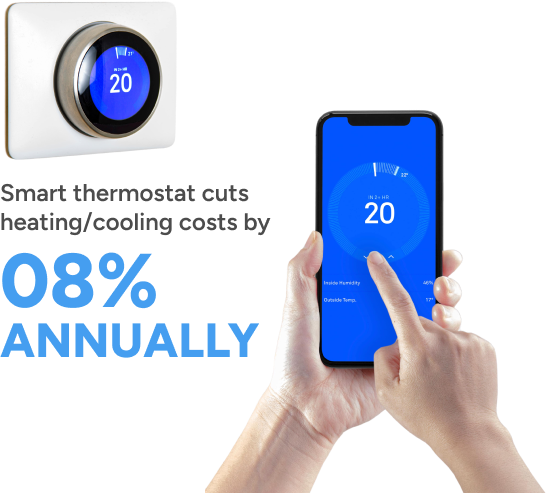
Another key area to consider is smart home lighting control systems, which work on timers to optimize energy use when you’re not at home. Motion sensors can also be useful in lighting up only rooms that are in use, and conserving energy in those that aren’t.
With this extensive range of energy-saving home automation technology, you’ll never have to worry about leaving a light, heating system, or television on again.
03
Time Saving
When you’re in a time crunch before leaving the house, the last thing you want to be doing is running around switching everything off, making sure that security systems are set, and checking the refrigerator ready for that post-work grocery shop.
However, as well as cutting financial costs, home automation can help you conserve valuable time to spend with your friends and family.
For example, based on foods that are low, your smart fridge will automatically create a shopping list that can be sent to your phone or tablet.
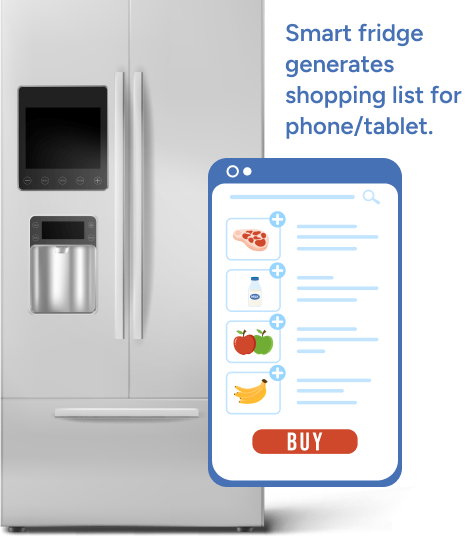
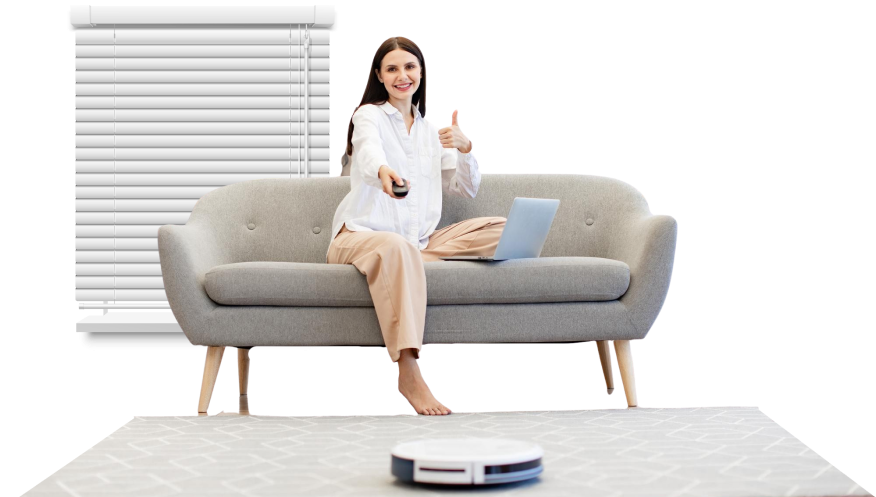
Smart appliances also allow you to streamline your daily routines.
While a smart vacuum can sweep away any dirt or dust at the touch of a button, automated curtains throughout the house will open for you each morning, allowing you to concentrate on getting more important things done.
04
Security
As we’ve mentioned, one of the biggest benefits of automating your home is the increased sense of security you’ll experience.
We know that motion sensors are a great invention for performing vital roles in and around the home, from switching on outdoor lights to recording video. However, home automation systems take this a step further, deterring intruders with a range of interconnected devices.
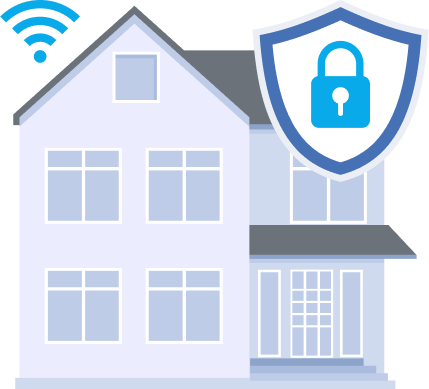
For instance, if you’re out and someone walks up to your porch, the camera motion detector will be activated. While recording straight away and alerting your phone, this doorbell device can also trigger your smart security system, turning on the lights and playing music from your smart speaker.
Furthermore, fire and smoke alarms, heat sensors, and carbon monoxide detectors can be connected to this system, therefore keeping your family safe in the event of an emergency.
05
Monitoring from Remote Locations
Whether you have an unexpectedly busy work schedule or are taking a planned vacation, the convenience of home automation means that you can keep tabs on your home from wherever you are. You’ll be in control of checking security feeds, receiving notifications, and adjusting settings, all from your mobile device.
With remote monitoring, you won’t need to rush home when a neighbor calls to say your security alarm is going off. Instead, thanks to built-in motion sensors and cameras, you can closely monitor the situation and only respond if really necessary.
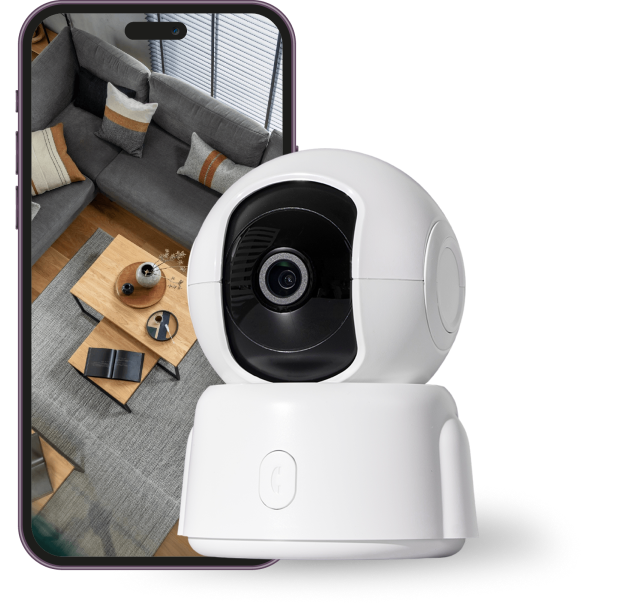
If you’re fed up with getting back to a cold, dark living space, you can even set your smart home up ready for your arrival. Switch lights on, turn the thermostat up, and select some music before you leave work to set an ambient tone for the rest of the evening.

